Email marketing delivers an average ROI of $42 for every dollar spent, making it one of the most effective marketing channels. However, this powerful tool comes with serious legal responsibilities that vary significantly across countries. Getting compliance wrong can result in devastating consequences: fines reaching €20 million under GDPR or up to 4% of total annual worldwide turnover in the previous financial year, whichever amount is higher, $10 million CAD under Canada’s CASL, or over $50,000 per email under US CAN-SPAM laws.
Beyond financial penalties, non-compliance can get your emails blocked by major providers, damage your brand reputation, and hurt your marketing effectiveness. The good news? Following best practices for the strictest laws should generally keep you compliant in most cases.
Master email marketing compliance worldwide
Navigate complex global email marketing laws with confidence. Learn essential compliance requirements, avoid costly penalties, and build permission-based campaigns that deliver results while respecting subscriber rights.
The global consent divide
Email marketing compliance splits into two main approaches, though the trend strongly favors stricter consent requirements.
The opt-in majority
Most countries now require explicit permission before sending marketing emails. The European Union led this movement with GDPR and the ePrivacy Directive, treating email addresses as personal data and requiring active consent for commercial emails. This approach has spread globally:
- European Union – GDPR + ePrivacy Directive
- Canada – CASL (one of the world’s strictest)
- Brazil – LGPD data protection law
- Australia & New Zealand – Spam Acts requiring consent
- South Korea – Must renew consent every 2 years
- Most of Asia-Pacific and Latin America
The opt-out exception
The United States remains a notable exception with CAN-SPAM, allowing businesses to email anyone until they opt out. However, even this system requires strict compliance with identification, honest subject lines, and easy unsubscribe mechanisms. Many US businesses voluntarily adopt opt-in practices, recognizing that permission-based marketing yields better results.
What makes consent valid?
Where consent is required, it must be:
- Explicit – Clear action e.g. checking a box
- Informed – Recipients understand what they’re signing up for specifically
- Voluntary – Not forced or hidden in terms of service
- Documented – You can prove when and how they consented
Red flags that invalidate consent: Pre-checked boxes, purchased lists, auto-adding business cards, assuming silence means agreement.
Regional requirements at a glance
| Region | Primary Laws (selected links) | Approach | Key Requirements | Possible Penalties (non-exhaustive) |
|---|---|---|---|---|
| European Union | GDPR + ePrivacy Directive | Strict opt-in | Clear consent, data rights, easy opt-out | €20M or 4% turnover |
| United States | CAN-SPAM Act | Opt-out allowed | Honest headers, clear opt-out, physical address | $50,000 per email |
| Canada | CASL | Very strict opt-in | Express/implied consent, detailed disclosures | $10M CAD |
| United Kingdom | UK GDPR + PECR | Opt-in required | Prior consent, clear identification, unsubscribe | £500,000 PECR or UK GDPR £17.5 million or 4% turnover |
| Australia | Spam Act 2003 | Opt-in required | Consent, identification, unsubscribe within 5 days | $1.8M AUD per day |
| New Zealand | Unsolicited Electronic Messages Act | Opt-in required | Consent, sender identification, opt-out | $500,000 NZD |
| Japan | Anti-Spam Act + ASCT | Opt-in required | Prior consent, proof retention 3 years | ¥30M or 1 year imprisonment |
| South Korea | PIPA + Network Act | Consent expires | 2-year consent renewal, “[광고]” label | Criminal charges possible |
| Singapore | PDPA + Spam Control Act | Mixed approach | <ADV> subject tag, consent preferred | $1M SGD |
| Hong Kong | UEMO | Implied consent | Clear sender ID, implied consent allowed | $1M HKD + 5 years prison |
| Brazil | LGPD | Opt-in required | Consent or legitimate interest, data protection | 2% revenue (max $50M BRL) |
| South Africa | POPIA | Opt-in required | Explicit consent, one unsolicited email allowed | R10M (~$536K USD) |
| Israel | Communications (Telecommunications & Broadcasting) Law – Sec. 30A | Opt-in required | Explicit consent, clear advertising labels | ₪202K + ₪1K per message |
| Russia | Federal Law on Advertising | Opt-in required | Consent required, poorly enforced | 6M rubles (~$75K USD) |
| China | Cybersecurity Law | Consent required | Data localization, security measures | Severe penalties for national security |
| India | Data Protection (overview) | General IT guidelines | No specific email law, cyber offense rules | ₹500,000 + 3 years prison |
| UAE | RUEC / TRA | Implicit consent | Minimum consent, data collection disclosure | AED 10M |
| Thailand | PDPA | Opt-in required | Explicit consent, data protection | 5M baht (~$140K USD) |
| Philippines | Data Privacy Act | Consent required | Consent for personal data processing | Varies by violation |
| Mexico | Federal Consumer Protection Law | Mixed approach | Limited scope, opt-out required | Varies by state |
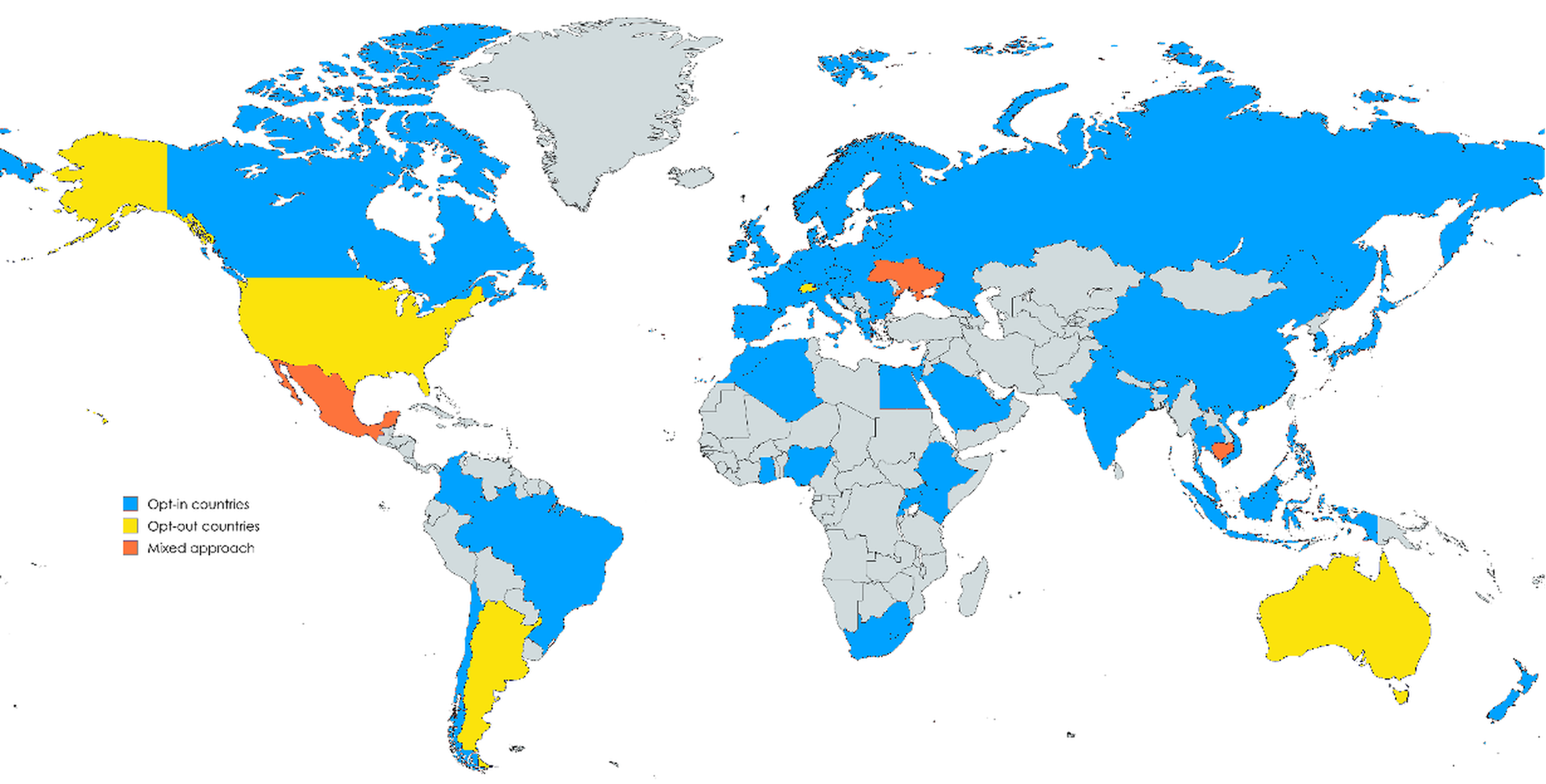
Key regional insights
European Union: Combines GDPR’s data protection with specific email rules. Regulators actively enforce, with major fines for invalid consent or failing to honor opt-outs. The “soft opt-in” exception allows emailing existing customers whose data were legally obtained about your own similar products with required easy objection mechanism. GDPR applies extraterritorially if a non-EU business offers goods or services to people in the EU or monitor behavior of individuals in the EU.
Canada: CASL goes beyond most laws, requiring detailed identification in every email and specific consent language (express and informed). Enforcement has extraterritorial reach affecting any business whose emails are sent to recipients in Canada.
United States: While allowing commercial emails without prior consent, CAN-SPAM still demands clear identification, physical addresses, honest subject lines, and functional unsubscribe mechanisms honored within 10 business days.
The issue of double opt-in
Double opt-in (also called confirmed opt-in) is an enhanced email consent process where subscribers must take two actions: first providing their email address, then clicking a confirmation link in a follow-up email to verify their subscription. While this extra step adds friction to list building, it provides stronger legal protection and higher-quality subscribers.
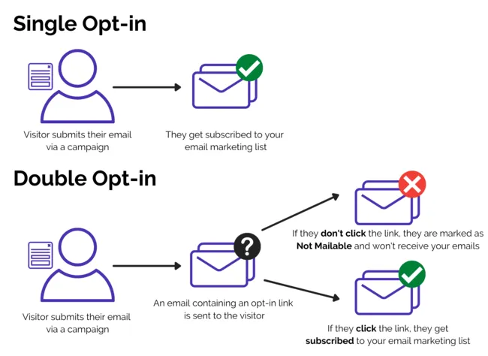
Where double opt-in is legally required
Germany stands out as the primary jurisdiction with clear rulings and interpretations requiring double opt-in. The German Federal Court of Justice (BGH) has ruled that single opt-in is insufficient to prove consent, stating that double opt-in is the appropriate means to verify consent as long as the confirmation email is completely neutral and contains no advertising. The German Data Protection Conference (DSK) guidelines, issued in February 2022, explicitly require double opt-in for electronic consent declarations.
Austria also requires double opt-in based on rulings by the Austrian Data Protection Authority, which recommended double opt-in consent as a security measure to protect personal data under Article 32 of the GDPR.
Where double opt-in is strongly recommended
Several countries’ data protection authorities recommend double opt-in as best practice without making it a legal requirement:
- Norway, Greece, Luxembourg, and Switzerland – Data protection authorities in these countries have issued guidance recommending double opt-in, though no legal requirement exists
- Netherlands – Privacy authorities suggest double opt-in for stronger consent evidence
- European Union broadly – While GDPR doesn’t require double opt-in, it’s considered best practice throughout the EU for ensuring consent is unambiguous and verifiable.
Where single opt-in remains sufficient
- United States – CAN-SPAM allows single opt-in or even opt-out approaches, though many email service providers recommend double opt-in for deliverability
- Canada – CASL requires explicit consent but doesn’t mandate double opt-in specifically
- United Kingdom – Post-Brexit UK GDPR follows EU patterns without requiring double opt-in
- Most other jurisdictions – Single opt-in with clear consent records typically satisfies legal requirements
When to choose double opt-in
Always use double opt-in when:
- Marketing to German or Austrian customers
- Handling sensitive personal data (health, financial)
- Building premium or high-value email lists
- Operating in highly regulated industries
- Targeting B2B decision-makers who value security
Consider single opt-in when:
- Rapid list growth is the primary goal
- Operating primarily in opt-out jurisdictions (like the US)
- Offering time-sensitive content or offers
- Targeting audiences with low technical sophistication
Hybrid approach: Some businesses use geolocation to apply double opt-in only to subscribers from countries where it’s required or strongly recommended, while using single opt-in for other regions.
Build compliant email lists with confidence
GetResponse provides built-in compliance tools including double opt-in, GDPR-ready forms, and automated consent management. Start building permission-based email campaigns that respect subscriber rights and deliver results.
Building compliant email lists
How you acquire email addresses determines both legal compliance and audience engagement.
✅ Compliant collection methods
Website sign-ups Use clear forms stating what subscribers will receive. “Marketing emails about our products” provides broader coverage than generic “newsletter” signups. Consider double opt-in for stronger consent proof, which is especially valuable in Germany where courts often require evidence the email owner personally consented.
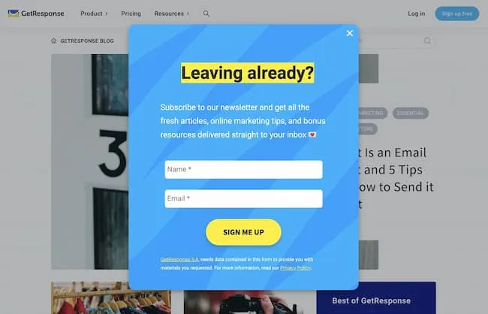
Offline collection
Explicitly ask permission at events or in stores: “May I add you to our newsletter?” Include clear language on paper forms: “By providing your email, you consent to receive marketing messages.”
Existing customers (“Soft Opt-in”) Many laws allow emailing current customers about similar products, but only if you:
- Collected the email legally during a sale or service
- Promote your own related offerings (not completely different products)
- Provided opt-out opportunities from the beginning
❌ High-risk practices
Purchased lists: Generally illegal in opt-in countries since recipients never consented to your emails specifically. Even “opt-in guaranteed” lists are misleading, as people consented to the list builder, not your business.
Email harvesting: Scraping websites or using automated address generation violates both privacy and anti-spam laws while damaging sender reputation.
Auto-adding business cards: Simply adding business cards to mailing lists without permission violates most anti-spam laws.
Essential email content requirements
Every marketing email must include specific elements for legal compliance and recipient trust.
Required elements
- Honest sender information
- Use your real company name in “From” field
- No deceptive names or fake identities
- Clear business identification
- Truthful subject lines
- Must reflect actual email content
- No bait-and-switch tactics (“Re: Your Order” for sales emails)
- Honest but engaging language
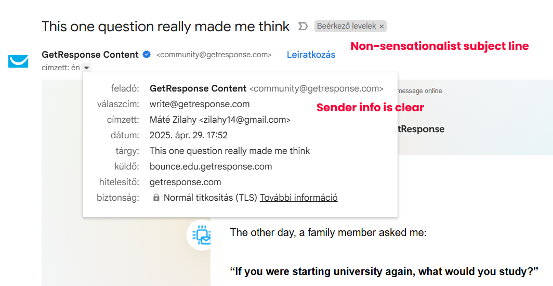
- Physical contact information
- Valid postal address (office, P.O. Box, or registered mail service)
- Required for clear identification of the sender and data controller
- Builds recipient confidence in legitimacy
- Clear unsubscribe mechanism
- Easy to find and use
- One-click process preferred
- No fees, surveys, or login requirements
- Process within deadlines depending on jurisdiction
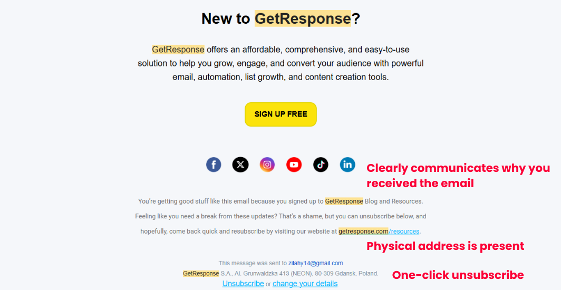
Privacy and data protection
Modern email marketing involves tracking and personalization, raising additional compliance considerations under privacy laws.
Email tracking considerations
Most marketing emails include tracking pixels for opens and unique links for clicks. Under strict privacy regimes like in EU, this tracking may require separate consent, similar to website cookies. European regulators increasingly expect consent for email tracking.
Best practices:
- Disclose tracking in privacy policy
- Offer opt-out options for tracking
- Obtain consent during signup: “By subscribing, you agree we may track opens and clicks”
Data use for personalization
Follow data minimization principles and only use data you lawfully collected for specified purposes. Personalizing with names or purchase history is generally acceptable if disclosed, but sensitive data (health, financial, children’s information) requires explicit consent and extra caution.
Handling data rights requests
Be prepared to respond to requests including for:
- Access: “What data do you have on me?”
- Deletion: “Delete all my information”
- Correction: “Update my details”
- Portability: “Give me my data in usable format”
Industry-specific rules
Certain industries face additional regulations affecting email marketing.
Healthcare (HIPAA in US)
- Need patient authorization for marketing using health information
- Cannot share patient lists without consent
- Separate general wellness content from targeted health communications
Financial services
- Must archive marketing emails (SEC/FINRA requirements)
- Include required disclaimers for investment advice
- Follow truth-in-advertising standards
Age-restricted products (alcohol, gambling, tobacco)
- Verify recipient age before sending
- Maintain self-exclusion lists for gambling
- Follow specific advertising restrictions and regulations
Children’s products (COPPA in US)
- Cannot collect emails from children under 13 without parental consent
- Need verifiable parental consent, not just checkboxes
- Consider directing marketing to parents instead
Technical compliance and deliverability
Compliance isn’t just about legal requirements – it’s also about ensuring your emails actually reach recipients’ inboxes. Email providers use increasingly sophisticated systems to identify and block non-compliant senders.
Email authentication standards
Proper email authentication has become essential for deliverability and compliance. SPF records authorize your domain to send email, DKIM provides cryptographic signatures proving email authenticity, and DMARC tells email providers how to handle messages that fail authentication. Gmail and Yahoo now require these authentication methods for bulk senders.
Beyond technical requirements, authentication helps prevent criminals from impersonating your business in phishing attacks, protecting both your brand and your customers.
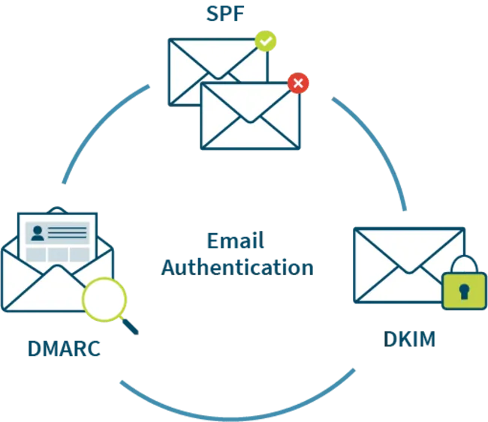
Sender reputation management
Email providers track sender behavior to identify spammers and protect their users. High complaint rates (over 0.3% of recipients marking emails as spam), frequent bounces to invalid addresses, and sudden volume spikes can all damage your sender reputation and lead to email blocking.
Maintaining good sender reputation requires ongoing attention to list quality, engagement rates, and sending patterns. Regular list cleaning, removing inactive subscribers, and monitoring engagement metrics help maintain good standing with email providers.
List hygiene and maintenance
Keeping your email list clean and current serves both compliance and deliverability goals. Remove hard bounces (invalid email addresses) immediately to avoid repeatedly sending to non-existent addresses. Consider re-engagement campaigns for subscribers who haven’t opened emails in extended periods, giving them a chance to confirm continued interest or automatically removing them from active sending.
Some jurisdictions, like South Korea, require periodic re-consent where marketing consent expires after two years. Even where not legally required, periodic confirmation helps ensure your list consists of genuinely interested recipients.
Quick compliance checklist
Before sending
☐ Verify valid consent for each recipient
☐ Match content to signup expectations
☐ Include required disclosures for target countries
☐ Test unsubscribe functionality
☐ Ensure proper email authentication
Content review
☐ Honest “From” name and address
☐ Accurate subject line
☐ Advertisement labels where required
☐ Physical address in footer
☐ Clear unsubscribe link
After sending
☐ Monitor complaint and bounce rates
☐ Process unsubscribes promptly
☐ Respond to data rights requests
☐ Update consent records
Stay compliant with GetResponse
GetResponse handles the technical complexity of email compliance for you. Built-in GDPR tools, automated consent management, proper authentication, and global deliverability infrastructure ensure your campaigns reach inboxes legally and effectively.
The bottom line
Email marketing compliance fundamentally comes down to respecting your subscribers. If you only email people who genuinely want to hear from you, provide value, make opting out easy, and protect their data, you’ll naturally comply with most laws while building a more engaged audience.
The golden rule: When in doubt, choose the stricter standard. Following GDPR or CASL requirements will generally keep you compliant in most cases, even if local laws are more permissive.
Remember that compliance isn’t a one-time achievement—it’s an ongoing process. Laws evolve, businesses change, and new technologies create fresh considerations. Build flexibility into your compliance program to stay ahead of requirements while maximizing email marketing effectiveness.
Your subscribers and your bottom line will thank you for the effort.
DISCLAIMER
Please note that information provided in this article is for general informational purposes only and does not constitute legal advice. Laws and regulations may change and interpretations can vary. You should not rely solely on the content herein and you should consider consulting a qualified legal professional in your local jurisdiction for guidance specific to your situation. GetResponse disclaims any liability for actions taken based on the information provided solely in the article.
